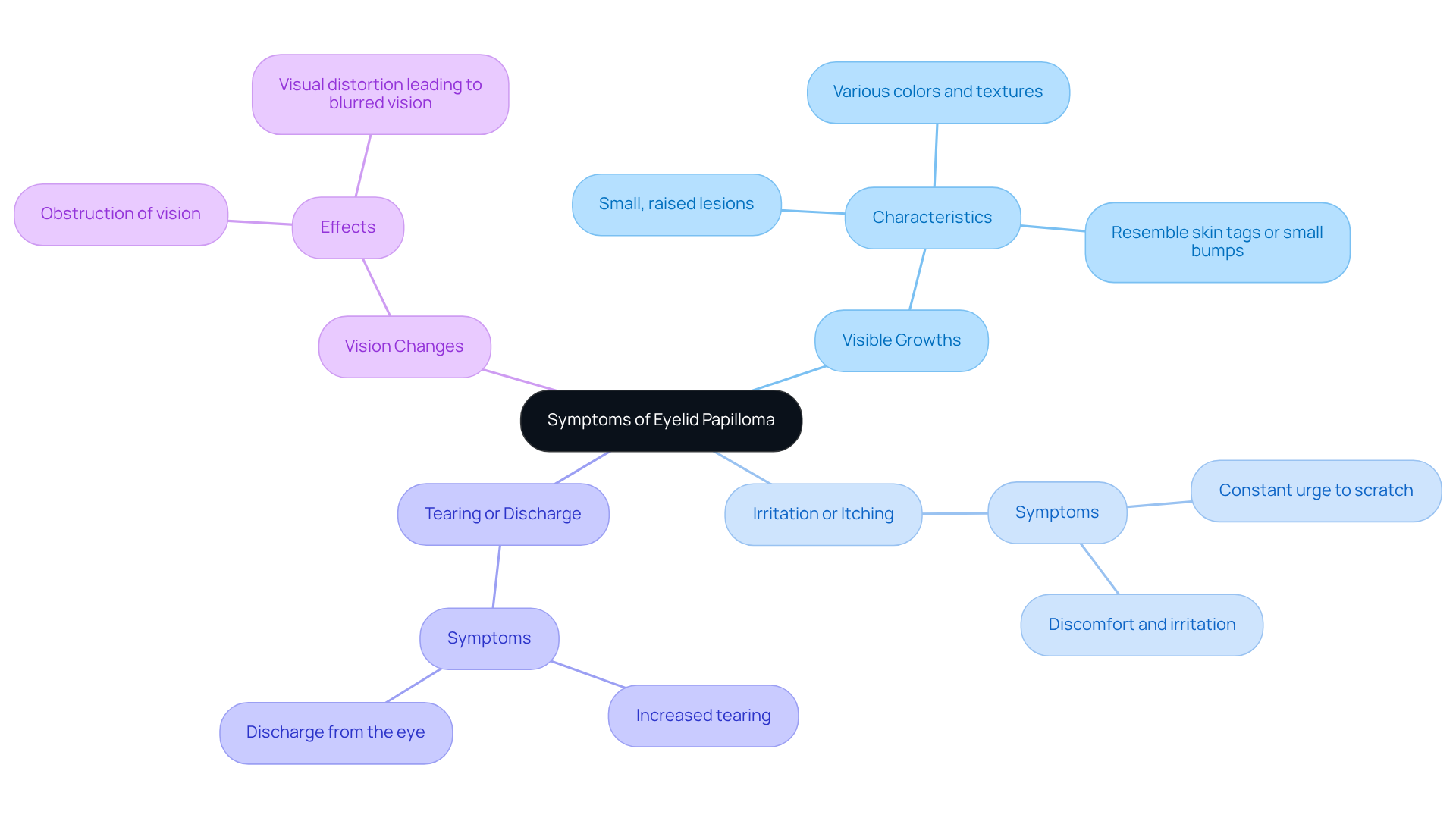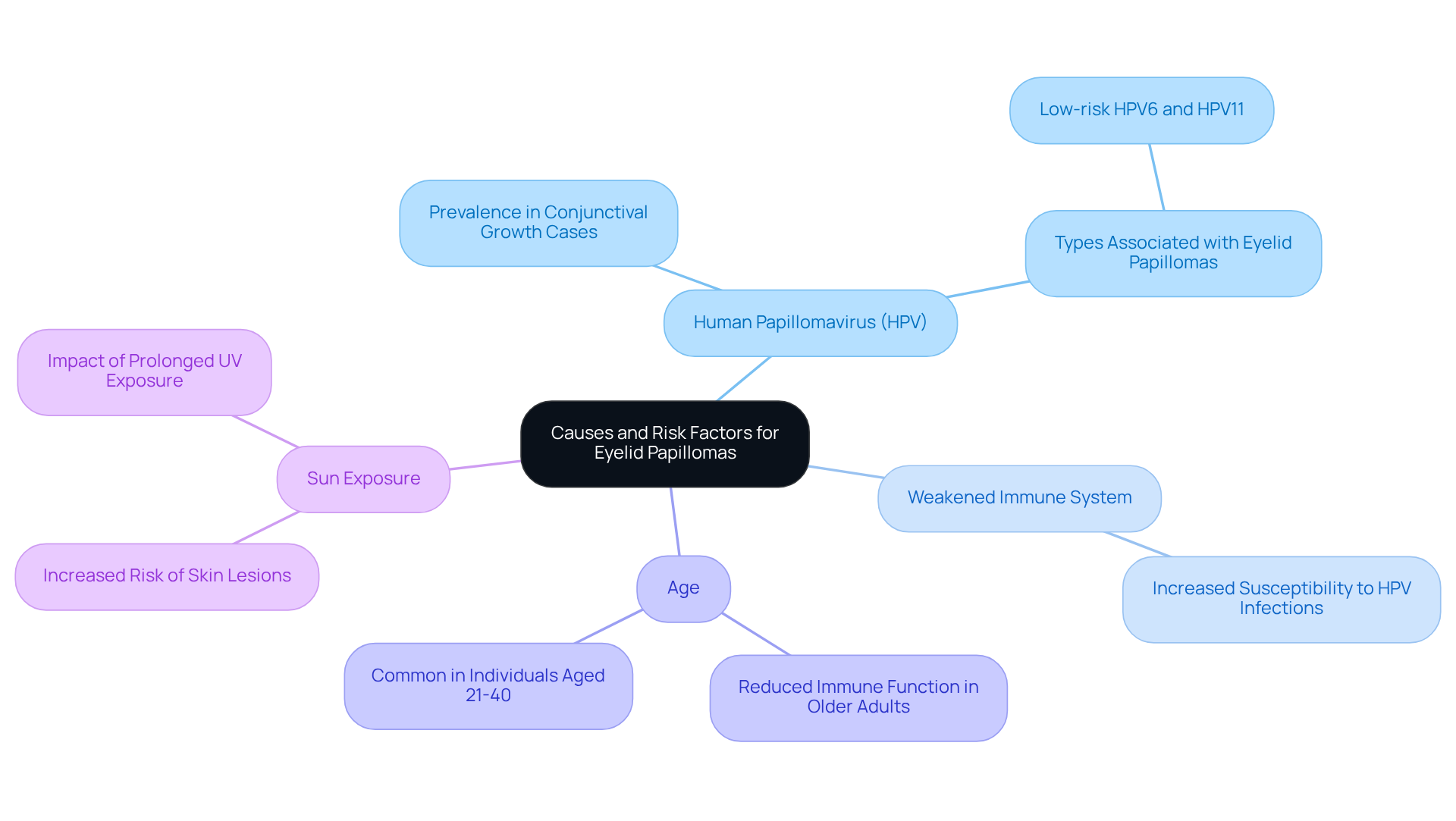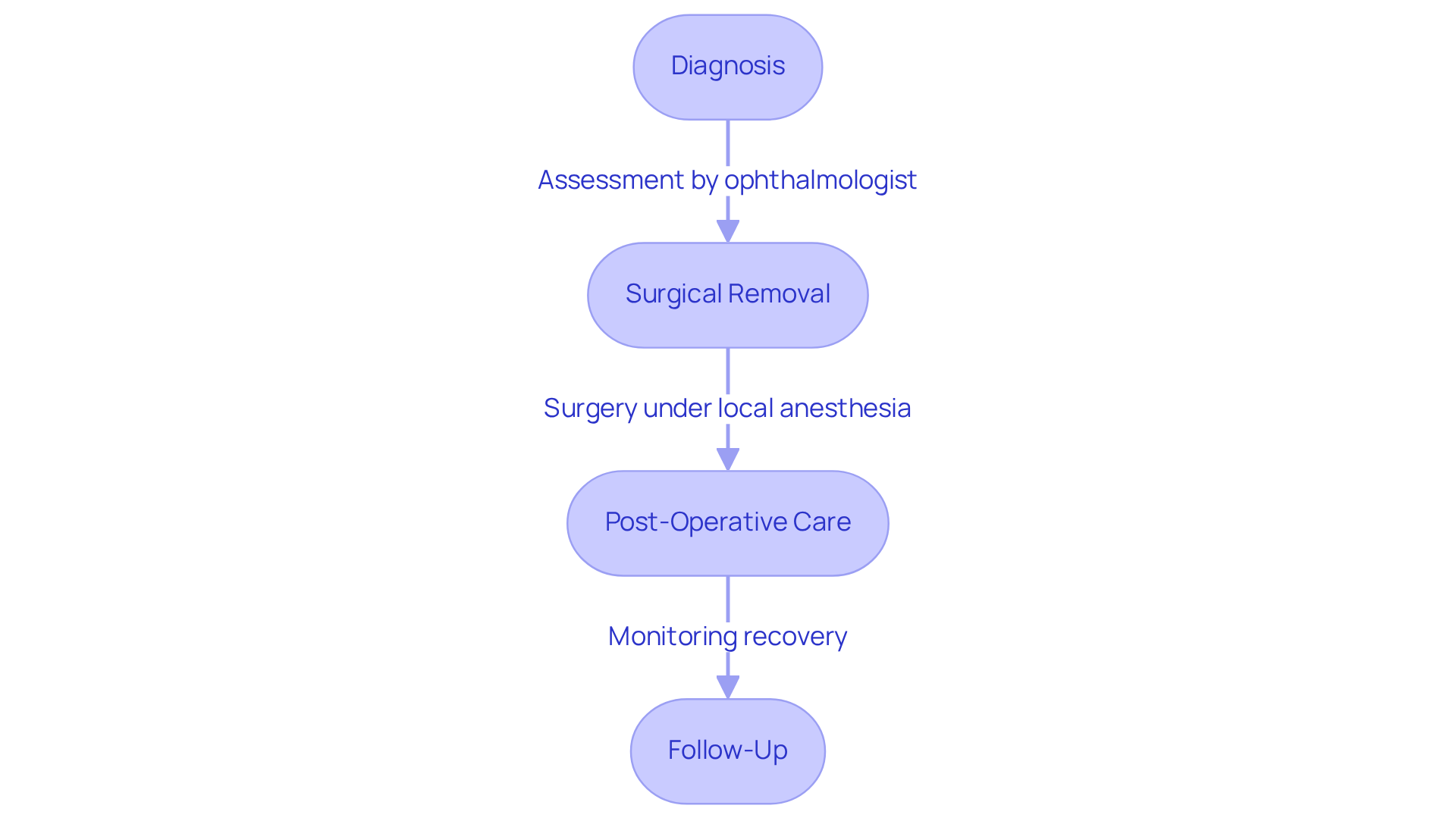Posted by: Northwest Eye in General on October 9, 2025
Overview
Eyelid papillomas are benign tumors primarily caused by the human papillomavirus (HPV). These growths can appear as small, wart-like formations that may lead to discomfort and cosmetic concerns. We understand that dealing with such issues can be distressing.
It’s essential to recognize the symptoms and understand the risk factors involved. Seeking timely treatment is crucial; early intervention can prevent complications and significantly improve your overall eye health.
Remember, we are here to help you through this process.
Introduction
Eyelid papillomas are benign tumors that appear as small, wart-like growths. We understand that discovering these lesions can evoke concern and confusion for many individuals. It’s important to recognize that while they may affect your appearance, they can also lead to discomfort and vision complications.
What causes eyelid papillomas, and how can you effectively manage their symptoms and treatment options? This article explores the symptoms, causes, and treatment strategies for eyelid papillomas, equipping you with the knowledge needed to navigate this common yet often misunderstood condition. We are here to help you through this process.
Define Eyelid Papilloma: Overview and Significance
Tumors on the eyelid area, known as papilloma eyelid, are benign growths that may appear as small, wart-like formations. We understand that discovering these lesions can be concerning. Primarily caused by human papillomavirus (HPV), papilloma eyelid growths can vary in size and color, typically presenting as flesh-colored, pink, or brown. While they are non-cancerous, they can lead to discomfort, irritation, and significant , impacting your quality of life. Their presence might obstruct vision or disrupt tear production, highlighting the importance of proper diagnosis and treatment to prevent complications.
Comprehending these growths is essential for efficient management. Prompt identification can help avert recurrence and more invasive interventions. For instance, a study revealed that:
- 68.9% of lesions were benign,
- most were found in the upper region of the eye,
- malignant lesions were more commonly seen in older populations.
This underscores the importance of regular eye examinations and being aware of symptoms, such as visible growths or persistent irritation.
Real-world examples from eye care clinics illustrate the significance of timely intervention. In one instance, an individual with a conjunctival growth experienced discomfort and vision obstruction, prompting early treatment that led to a favorable outcome. Such situations highlight the necessity for healthcare professionals to recognize growths on the eyelids and guide individuals to specialists when necessary.
As noted by experts in the field, “Eyelid growths are considered one of the most common non-cancerous tumors observed in clinical practice.” This reinforces the importance of patient education and proactive management strategies. By staying informed about the origins, signs, and care options for eye growths, you can improve your eye health and overall wellness. Remember, we are here to help you through this process.

Explore Types of Eyelid Papillomas: Classifications and Characteristics
Papilloma eyelid can be classified into several types, and we understand that learning about them can be concerning. Here are the main types:
- Verrucous Papilloma: These are the most common type found on the eyelids, characterized by a rough, wart-like surface.
- Squamous Papilloma Eyelid: These soft, flesh-colored growths may appear smooth or slightly raised, and it’s normal to have questions about them.
- Cylindroma: This rarer form typically presents as dome-shaped tumors, which can sometimes be mistaken for other skin lesions.
Each type has unique characteristics that may influence the choice of treatment. We want to emphasize that is crucial for effective management. Remember, you are not alone in this journey, and we are here to help you through the process.

Recognize Symptoms of Eyelid Papilloma: Key Indicators to Watch For
Common symptoms of papilloma eyelid can be concerning, and recognizing them is an important step towards seeking help. Here are some key signs to watch for:
- Visible Growths: These small, raised lesions may appear in various colors and textures, often resembling skin tags or small bumps on the eyelid. Papilloma eyelid growths are among the most prevalent non-cancerous tumors seen in clinical practice, and it’s understandable to feel anxious about them.
- Irritation or Itching: Many individuals report discomfort, often feeling a constant urge to scratch the affected area, which can lead to further irritation. We understand that this can be quite bothersome.
- Tearing or Discharge: Increased tearing or discharge from the eye may occur, indicating irritation or inflammation in the surrounding tissues. It’s common to feel worried when experiencing these symptoms.
- Vision Changes: In cases where larger papilloma eyelids develop, they may obstruct vision or cause visual distortion, leading to blurred vision. This is particularly important for cataract patients, as any changes in vision should prompt immediate medical evaluation.
Recognizing these symptoms is crucial for timely medical evaluation and intervention. Early identification can lead to effective management and relief from discomfort. We encourage you to or dermatologist for proper diagnosis and treatment options.
Furthermore, if eyelash tumors are excised, the recovery duration for the incision site is generally within one to two weeks. It’s important to remember that differential diagnoses, such as chalazion, basal cell carcinoma, and papilloma eyelid, should also be considered when evaluating eyelid lesions. We are here to help you through this process and support you every step of the way.

Identify Causes and Risk Factors: Understanding Triggers for Eyelid Papillomas
Eyelid growths can be concerning, and it’s important to understand that they are mainly induced by the human papillomavirus (HPV), which spreads through direct contact with infected skin. In fact, HPV is noted in over 50% of conjunctival growth cases, highlighting its significant role in the formation of these lesions.
Key risk factors to be aware of include:
- Weakened Immune System: If you have a compromised immune system, you may be more susceptible to HPV infections, increasing the likelihood of developing eyelid papillomas.
- Age: It’s common for older adults to face a heightened risk due to decreased immune function, which can diminish the body’s ability to effectively combat HPV. Limbal growths often impact older individuals, especially those with a history of extended UV exposure, further increasing their susceptibility.
- Sun Exposure: Prolonged exposure to UV rays significantly raises the chance of developing skin lesions, including growths. This is particularly true for older individuals who may have accumulated sun damage over the years.
Eyelid growths are among the most prevalent non-cancerous tumors seen in clinical practice. Recognizing these factors is crucial for taking preventive measures, such as reducing sun exposure. If you notice any concerning symptoms, including eye irritation, a foreign body sensation, or excessive tearing, we encourage you to seek timely medical advice. Understanding HPV’s , specifically papilloma eyelid, can lead to improved management and treatment outcomes. We are here to help you through this process.

Explore Treatment Options for Eyelid Papilloma: From Diagnosis to Recovery
Treatment for eyelid papillomas generally follows a structured approach that prioritizes your comfort and understanding:
- Diagnosis: We understand that discovering growths can be concerning. An ophthalmologist will perform a thorough assessment to verify the existence of these growths, utilizing advanced diagnostic tools to ensure precision.
- Surgical Removal: The main procedure involves excising the papilloma, typically performed under local anesthesia. This procedure is efficient, often completed within a brief timeframe. Most individuals can anticipate minimal recovery time, allowing them to return to daily activities quickly. Dr. Nathan Schramm emphasizes, “Our emergency care team is prepared to manage any urgent eye situation, ensuring that individuals receive comprehensive care throughout the treatment process.”
- Post-Operative Care: After surgery, you will receive specific instructions on caring for the surgical site, including how to watch for signs of papilloma eyelid, to prevent infection and promote optimal healing. It’s important to keep the area clean and monitor for any unusual symptoms, and we are here to help you through this process.
- Follow-Up: Regular follow-up appointments are essential for evaluating your recovery and monitoring for any recurrence of tumors. Research shows that around 0% of inverted tumors may return within the initial years, highlighting the significance of continuous observation. Additionally, we encourage you to consider HPV vaccination as a preventive measure against conjunctival papillomas.
By understanding these treatment options, you can make informed decisions regarding your eye health. We are here to support you every step of the way, ensuring timely intervention that leads to improved outcomes and comfort.

Conclusion
Eyelid papillomas, though benign, can profoundly affect both physical comfort and emotional well-being. We understand that these growths may lead to discomfort, irritation, and even obstruct vision. Recognizing the signs and symptoms early is crucial, as it allows for timely medical intervention and helps prevent complications, ultimately enhancing your quality of life.
In this article, we have discussed key points, including the various types of eyelid papillomas and their primary cause, which is linked to human papillomavirus (HPV). Symptoms such as visible growths, irritation, and potential changes in vision serve as critical indicators for seeking medical advice. Furthermore, a structured approach to treatment—from diagnosis to post-operative care—highlights the necessity of professional guidance in managing these conditions effectively.
Ultimately, awareness and education about eyelid papillomas are essential for proactive health management. We encourage you to stay vigilant regarding your eye health. Consult with healthcare professionals when symptoms arise, and consider preventive measures like HPV vaccination. By taking these steps, you can significantly improve your eye health and overall well-being, ensuring that any concerns are addressed promptly and effectively.
Frequently Asked Questions
What is an eyelid papilloma?
An eyelid papilloma is a benign tumor that appears as small, wart-like growths on the eyelid area, primarily caused by human papillomavirus (HPV). They can vary in size and color, typically being flesh-colored, pink, or brown.
Are eyelid papillomas cancerous?
No, eyelid papillomas are non-cancerous growths. However, they can cause discomfort, irritation, and cosmetic concerns, and may obstruct vision or disrupt tear production.
Why is it important to diagnose eyelid papillomas?
Proper diagnosis is crucial to prevent complications, recurrence, and the need for more invasive treatments. Regular eye examinations and awareness of symptoms can help in early identification.
What percentage of eyelid lesions are benign?
A study indicated that 68.9% of eyelid lesions are benign, highlighting the prevalence of non-cancerous growths in this area.
What are the common types of eyelid papillomas?
The main types of eyelid papillomas include:
- Verrucous Papilloma: The most common type with a rough, wart-like surface.
- Squamous Papilloma Eyelid: Soft, flesh-colored growths that may be smooth or slightly raised.
- Cylindroma: A rarer type that presents as dome-shaped tumors and can be mistaken for other skin lesions.
How can eyelid papillomas affect quality of life?
While benign, eyelid papillomas can lead to discomfort, irritation, and significant cosmetic issues, which may impact a person’s quality of life.
What should I do if I notice growths on my eyelids?
If you notice growths or experience persistent irritation on your eyelids, it is important to seek medical attention for proper evaluation and potential referral to a specialist.






